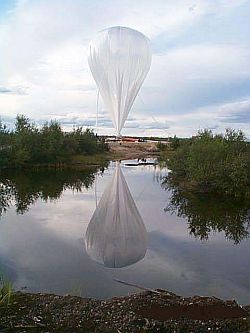 BIG 60 (balloon)
BIG 60 (balloon)

The "BIG 60" was the unofficial denomination of a zero-pressure balloon of 60 million cubic feet of volume which was developed by Raven/Aerostar for the NASA balloon program in 2002.
The gigantic balloon was born in the framework of an initiative known as Ultra-High Altitude Balloon (UHAB) which was focused on the possibility to fly payloads in the range of 900-1000 kg to altitudes in excess of 45 km using traditional zero-pressure designs.
In late 90's while NASA was developing the Ultra Long Duration Balloon (ULDB) platform several programs were started to improve the reliability of standard zero-pressure balloons, and the quality of balloon film. On this basis, in March, 2002, NASA requested to Raven Industries to perform a study for a UHAB platform with 60 million cubic feet of volume an able to carry a payload of 750 kg. While the balloon's main envelope was designed using traditional zero-pressure techniques, the shell and cap material were made of Stratofilm-430, a three-layer co-extruded film that used the same resins of the film developed originally for the ULDB program. Stratofilm-430 has higher strength and ductility at normal surface temperatures, making the shell better able to withstand dynamic launch loads.
It was manufactured in mid-2002 at the Raven/Aerostar plant of Sulphur Springs in Texas. The construction required some minor rearrangement of production space to accommodate the enlarged size of the balloon gores and special training and handling exercises to acclimate personnel to the more delicate films. Once finished, it was sent to Canada to participate in NASA's summer launch campaign at Lynn Lake, Manitoba. After several weeks of delays due to adverse weather, it was finally launched on August 25, transporting a 690 kg cosmic ray instrument called Low Energy Electrons (LEE) provided by the University of Delaware. The balloon climbed to a peak altitude of 49.4 km, and was terminated normally after approximately 23 hours of flight time.
This was the largest balloon ever successfully flown.

